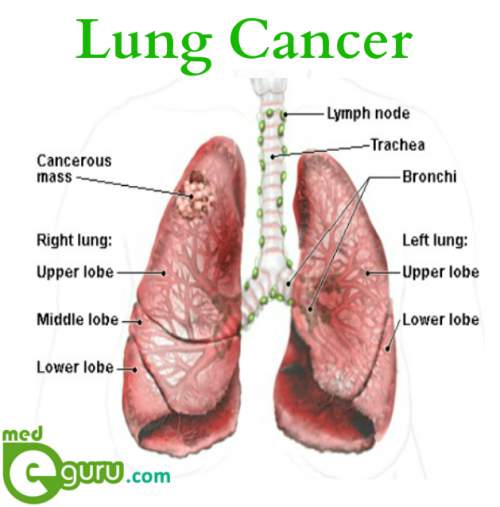What is lung cancer?
A kind of cancer that develops in the lungs is called ‘ lung cancer ‘. The lungs are a pair of spongy organs on either side of the chest. They help to take in oxygen and release carbon dioxide when you inhale and exhale. Lung cancer is considered as one of the leading causes for death in many countries. Smoking is a dangerous habit that leads to lung cancer in people. However, lung cancer is preventable. Quitting smoking can significantly reduce the risk for developing lung cancer.
What are the symptoms of Lung cancer?
During the early stages, lung cancer will not cause any noticeable signs and symptoms. They can be identified only in the advanced stage. Some of the signs and symptoms of lung cancer include the following:
-
Headache
-
Bone pain
-
Shortness of breath
-
Wheezing
-
Cough that doesn’t go away
-
“Smoker’s cough”
-
Blood in the cough (can be a small amount)
-
Hoarseness
-
Losing weight without trying
-
Chest pain
If one notices any of the above-mentioned symptoms, take an appointment with the doctor.
What causes lung cancer?
Majority of the lung cancer cases are caused due to smoking. People who are exposed to secondhand smoke are also prone to develop lung cancer. According to medical experts, cancer-causing substances in the cigarette damage the cells inside the lungs. Prolonged exposure causes severe damage, and thereby results in lung cancer.
What are the types of lung cancer?
This cancer is classified into two types based on the appearance of the lung cancer cells seen under a microscope. The treatment will be determined based on the type of lung cancer. The two types include:
-
Small cell lung cancer: Usually, it is seen among heavy smokers and is less common.
-
Non-small cell lung cancer: Various types of lung cancers that behave in the similar way are collectively known as non-small cells lung cancer. It includes cancers like adenocarcinoma lung cancer, squamous cell carcinoma, and large cell carcinoma.
How is lung cancer diagnosed?
If the doctor doubts one affected by this cancer, he/she may suggest various diagnostic tests and procedures. Some of them include:
-
X-ray to find abnormal mass or growth
-
CT scan to find small lesions in the lungs
-
Sputum cytology
-
Biopsy of the tissue sample
Lung cancer stages
After confirming lung cancer in a patient, the next step is to determine the stage. The doctor will conduct various tests such as CT scans, Position emission tomography (PET), bone scans etc, to identify the stage. The main stages of lung cancer:
-
Stage I: Cancer is not spread to the lymph nodes and limited only to the lungs.
-
Stage II: The tumor may grow during this stage. Cancer may also spread to the lungs.
-
Stage III: The tumor may grow very large. It will even invade the organs near the lungs.
-
Stage IV: Cancer may spread beyond the lung and other areas of the body.
What are the Lung cancer treatment options?
The cancer treatment plan may vary based on various factors like:
-
Overall health of the patient
-
The type and stage of cancer
-
Choice of the doctor as well as the patient
Treatment options include surgery which removes the cancer as well as a margin of the health tissue. There are different surgical procedures to remove the lung cancer:
-
Segmental resection
-
Lobectomy
-
Wedge resection
-
Pneumonectomy
-
Chemotherapy: Drugs are used to kill chemotherapy.
-
Radiation therapy: High-powered energy beams are used to kill the cancer cells.
-
Targeted drug therapy: Targets specific anomalies in cancer cells.

Pingback: Air Pollution makes Delhi world’s most polluted city - medeguru.com()